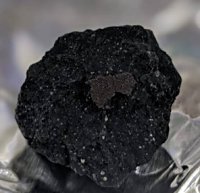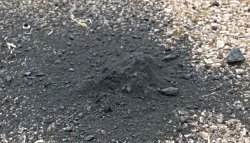
Photo Credit: The Trustees of the Natural History Museum, London
 Photo Credit: The Trustees of the Natural History Museum, London | Could Meteorites have brought water to Earth? |
Carbon-rich meteorites known as carbonaceous chondrites are relatively rare. In fact they constitute only about 5% of all known meteorites. But those meteorites are important, both as a window into early solar formation and because scientists believe that they hold clues as to how life started on Earth. This Is because carbonaceous chondrites contain nucleobases which are essential building blocks of RNA and DNA. Therefore the arrival of nucleobases may have been the trigger for life on Earth.
One of the major drawbacks when studying meteorites which landed on Earth a long time ago is the possibility of contamination or chemical modification between the time of arrival and time of discovery. This is why the Winchcombe meteorite has been such an important find. The Winchcombe fireball was observed at approximately 10 pm on 28 February 2021. Its arrival was documented by no less than 16 dedicated meteor cameras and captured by numerous dashcam videos. Many eyewitnesses also reported the event.

Credit: Rob, Cathryn and Hannah Wilcock
The main mass of the meteorite (319.5 grams) landed in the town of Winchcombe in Gloucestershire, UK. More precisely, it landed on a driveway, smashing into fragments and powder on impact. The owners found small stones and debris the following morning, scooped the remains into freezer bags and alerted the UK Meteor Observation Network. By evening researchers were at the site to collect the samples. It was important to ensure that the meteorite samples were in near as possible to pristine condition, uncontaminated by terrestrial material.
Analysis of video recordings of the meteorite as it plunged through the atmosphere gave details of its journey. It originally came from an asteroid belt between Mars and Jupiter and began moving toward Earth around 300,000 years ago. The Winchcombe meteorite is believed to share its source of origin with two other carbonaceous chondrites which are also relatively recent arrivals. (Those being Sutter's Mill meteorite, which landed near Sutter's Mill, a California Gold Rush site on April 22 2021, and Maribo CM chondrite which fell on the 17th of January 2009 in Denmark.)
Analysis showed that the Winchcombe meteorite was indeed a rare carbonaceous chondrite, the very first ever to be found in the United Kingdom. The meteorite is 4.6 billion years old and probably originated from the near-surface regolith of its parent asteroid.
Imaging and chemical analysis confirmed the similarities with other carbon-rich chondrites. The carbon content was estimated at 2 percent. But probably the most interesting find was that the meteorite is about 11% extraterrestrial water, locked in hydrated minerals. Some of the hydrogen was in the heavy form known as deuterium. The ratio between hydrogen and deuterium in the meteorite was similar to that in Earth's atmosphere.
This opens the possibility that this is how water was originally brought to Earth. That is, meteorites, similar to the Winchcombe meteorite, broke off from water-rich parent asteroids, and fell in large numbers onto the Earth during the early formation of the solar system.
As Ashley King - the lead author of a recent publication in the journal Science Advances - comments: "It [the Winchcombe meteorite] is a good indication that water [on Earth] was coming from water-rich asteroids,"
Journal Reference:
| _______________________________ | ||||
| Home | | | Shopping | | | Database |
© Biscuit Software 2004-2019
All rights reserved